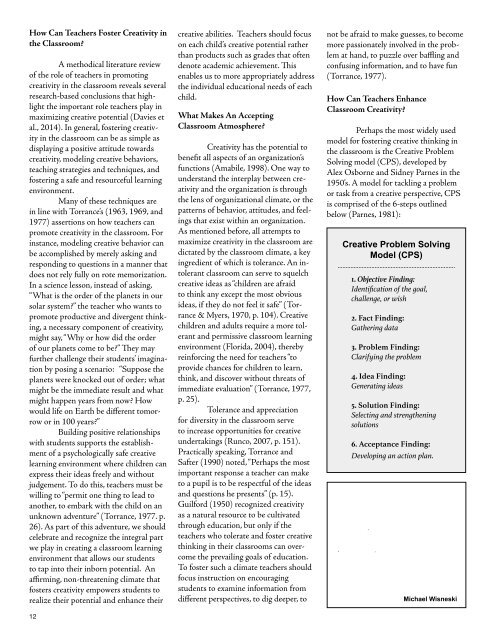Torrance Journal for Applied Creativity
TorranceJournal_V1
TorranceJournal_V1
You also want an ePaper? Increase the reach of your titles
YUMPU automatically turns print PDFs into web optimized ePapers that Google loves.
How Can Teachers Foster <strong>Creativity</strong> in<br />
the Classroom?<br />
A methodical literature review<br />
of the role of teachers in promoting<br />
creativity in the classroom reveals several<br />
research-based conclusions that highlight<br />
the important role teachers play in<br />
maximizing creative potential (Davies et<br />
al., 2014). In general, fostering creativity<br />
in the classroom can be as simple as<br />
displaying a positive attitude towards<br />
creativity, modeling creative behaviors,<br />
teaching strategies and techniques, and<br />
fostering a safe and resourceful learning<br />
environment.<br />
Many of these techniques are<br />
in line with <strong>Torrance</strong>’s (1963, 1969, and<br />
1977) assertions on how teachers can<br />
promote creativity in the classroom. For<br />
instance, modeling creative behavior can<br />
be accomplished by merely asking and<br />
responding to questions in a manner that<br />
does not rely fully on rote memorization.<br />
In a science lesson, instead of asking,<br />
“What is the order of the planets in our<br />
solar system?” the teacher who wants to<br />
promote productive and divergent thinking,<br />
a necessary component of creativity,<br />
might say, “Why or how did the order<br />
of our planets come to be?” They may<br />
further challenge their students’ imagination<br />
by posing a scenario: “Suppose the<br />
planets were knocked out of order; what<br />
might be the immediate result and what<br />
might happen years from now? How<br />
would life on Earth be different tomorrow<br />
or in 100 years?”<br />
Building positive relationships<br />
with students supports the establishment<br />
of a psychologically safe creative<br />
learning environment where children can<br />
express their ideas freely and without<br />
judgement. To do this, teachers must be<br />
willing to “permit one thing to lead to<br />
another, to embark with the child on an<br />
unknown adventure” (<strong>Torrance</strong>, 1977. p.<br />
26). As part of this adventure, we should<br />
celebrate and recognize the integral part<br />
we play in creating a classroom learning<br />
environment that allows our students<br />
to tap into their inborn potential. An<br />
affirming, non-threatening climate that<br />
fosters creativity empowers students to<br />
realize their potential and enhance their<br />
12<br />
creative abilities. Teachers should focus<br />
on each child’s creative potential rather<br />
than products such as grades that often<br />
denote academic achievement. This<br />
enables us to more appropriately address<br />
the individual educational needs of each<br />
child.<br />
What Makes An Accepting<br />
Classroom Atmosphere?<br />
<strong>Creativity</strong> has the potential to<br />
benefit all aspects of an organization’s<br />
functions (Amabile, 1998). One way to<br />
understand the interplay between creativity<br />
and the organization is through<br />
the lens of organizational climate, or the<br />
patterns of behavior, attitudes, and feelings<br />
that exist within an organization.<br />
As mentioned be<strong>for</strong>e, all attempts to<br />
maximize creativity in the classroom are<br />
dictated by the classroom climate, a key<br />
ingredient of which is tolerance. An intolerant<br />
classroom can serve to squelch<br />
creative ideas as “children are afraid<br />
to think any except the most obvious<br />
ideas, if they do not feel it safe” (<strong>Torrance</strong><br />
& Myers, 1970, p. 104). Creative<br />
children and adults require a more tolerant<br />
and permissive classroom learning<br />
environment (Florida, 2004), thereby<br />
rein<strong>for</strong>cing the need <strong>for</strong> teachers “to<br />
provide chances <strong>for</strong> children to learn,<br />
think, and discover without threats of<br />
immediate evaluation” (<strong>Torrance</strong>, 1977,<br />
p. 25).<br />
Tolerance and appreciation<br />
<strong>for</strong> diversity in the classroom serve<br />
to increase opportunities <strong>for</strong> creative<br />
undertakings (Runco, 2007, p. 151).<br />
Practically speaking, <strong>Torrance</strong> and<br />
Safter (1990) noted, “Perhaps the most<br />
important response a teacher can make<br />
to a pupil is to be respectful of the ideas<br />
and questions he presents” (p. 15).<br />
Guil<strong>for</strong>d (1950) recognized creativity<br />
as a natural resource to be cultivated<br />
through education, but only if the<br />
teachers who tolerate and foster creative<br />
thinking in their classrooms can overcome<br />
the prevailing goals of education.<br />
To foster such a climate teachers should<br />
focus instruction on encouraging<br />
students to examine in<strong>for</strong>mation from<br />
different perspectives, to dig deeper, to<br />
not be afraid to make guesses, to become<br />
more passionately involved in the problem<br />
at hand, to puzzle over baffling and<br />
confusing in<strong>for</strong>mation, and to have fun<br />
(<strong>Torrance</strong>, 1977).<br />
How Can Teachers Enhance<br />
Classroom <strong>Creativity</strong>?<br />
Perhaps the most widely used<br />
model <strong>for</strong> fostering creative thinking in<br />
the classroom is the Creative Problem<br />
Solving model (CPS), developed by<br />
Alex Osborne and Sidney Parnes in the<br />
1950’s. A model <strong>for</strong> tackling a problem<br />
or task from a creative perspective, CPS<br />
is comprised of the 6-steps outlined<br />
below (Parnes, 1981):<br />
Creative Problem Solving<br />
Model (CPS)<br />
1. Objective Finding:<br />
Identification of the goal,<br />
challenge, or wish<br />
2. Fact Finding:<br />
Gathering data<br />
3. Problem Finding:<br />
Clarifying the problem<br />
4. Idea Finding:<br />
Generating ideas<br />
5. Solution Finding:<br />
Selecting and strengthening<br />
solutions<br />
6. Acceptance Finding:<br />
Developing an action plan.<br />
Michael Wisneski


